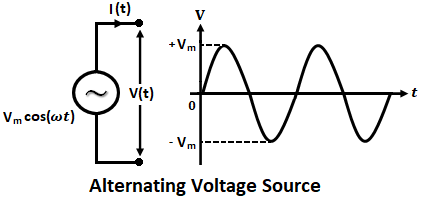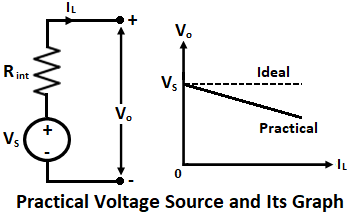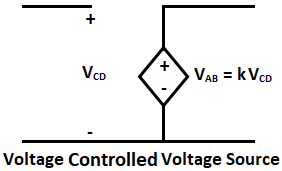An electrical source is a circuit component that supplies electrical energy in the form of voltage or current. All electrical and electronic circuits require a source of supply of voltage or current for their operation.
Energy-supplying sources are considered as active components which can be a voltage source or current source. In this article, let us learn about what is a voltage source and different types of voltage sources.
What is a Voltage Source?
A voltage source refers to a source of energy that generates potential difference across its terminal. In other words, a voltage source is a two-terminal circuit component that establishes prescribed voltage across its terminals.
A voltage source is one of the most important active elements we encounter in everyday life. Examples of voltage sources are cells, batteries, dc generators, alternators, piezoelectric disks, etc.
Types of Voltage Sources :
Based on the dependency of voltage, voltage sources are divided into two types,- Independent Voltage Source.
- Dependent Voltage Source.
Independent Voltage Source :
The voltage source whose output voltage doesn't depend upon any circuit element is said to be known as Independent Voltage Source. In other words, the independent voltage sources supply a voltage that is not affected or influenced by other circuit variables. For example, a 5V independent voltage source will maintain the voltage at 5V regardless of the amount of current drawn in the circuit.
Based on the type of voltage, independent voltage sources are divided into two types,- Direct Voltage Source or Time Invariant Voltage Source
- Alternating Voltage Source.
Direct Voltage Source :
A direct voltage source is one whose polarity of the voltage remains constant. Direct voltage sources have fixed positive and negative polarity terminals which do not vary with time. The current in a circuit with a direct voltage source always flows in one direction only i.e., from positive to negative terminal. Examples of direct voltage sources are dc generators, cells, batteries, etc. The below shows the circuit symbol of a direct voltage source.
Alternating Voltage Source :
An alternating voltage source is a time-variant voltage source, whose magnitude changes continuously and polarity gets reversed at regular intervals. Due to reversing of the polarity i.e., positive and negative polarities, the direction of the flow of electrons or current through the circuit changes with respect to the polarity. The below shows the circuit symbol of the alternating voltage source.
It should be noted that the change in magnitude of the voltage of an alternating voltage source is not due to the effect of any other circuit element but it varies with time. Examples of alternating voltage sources are alternators, inverters, etc.
Based on internal resistance, independent voltage sources may also classify as,- Ideal Voltage Source
- Practical Voltage Source.
Ideal Voltage Sources :
An ideal voltage source or constant voltage source is one that supplies fixed and constant potential difference no matter how much amount of current is drawn in the circuit. In order words, the terminal voltage of an ideal voltage source is completely independent of the load and other circuit components.
An ideal voltage source has zero internal resistance. Due to zero internal resistance, there is no voltage drop and thus the voltage across the terminals will same as the voltage produced in the source. An ideal voltage source is considered the Independent Voltage Source because its terminal voltage doesn't depend upon the current flowing in the circuit or any of the circuit parameters.
For example, a 12V ideal source will supply 12V across its terminal for 1MΩ resistor load as well as for 1kΩ resistor or when 1Ω resistor is connected. Here voltage remains constant and current varies,- For 1MΩ resistor current I = 12V/1MΩ = 12μA.
- For 1kΩ resistor current I = 12V/1kΩ = 12mA.
- For 1Ω resistor current I = 12V/1Ω = 12A.
The circuit symbol and V-I characteristics of an ideal voltage source which will be a straight line are shown below.
In practice, it is impossible to build an ideal voltage source with zero internal resistance because every voltage source has some internal resistance. But a voltage source can be considered an ideal voltage source if it has negligible or very small internal resistance.
For example, a voltage source of 6V has 0.005Ω internal resistance. If the load current varies between 1 to 10A, the drop across internal resistance will be less than 0.05V. Therefore the terminal voltage of the voltage source lies between 5.995V and 5.95V. This very small internal drop in voltage source can be neglected and thus it can be considered as the ideal voltage source.
A lead acid cell is an example of an ideal voltage source. The internal resistance of a lead-acid cell is 0.01Ω which is very small and thus it is considered the ideal voltage source in practice.
Practical Voltage Sources :
Above we have seen the ideal voltage source, but in real all the voltage sources do have some internal resistance due to which the terminal voltage will differ from the actual voltage generated by the source. This change in voltage is on account of internal voltage drop caused by internal resistance which varies with the amount of current drawn in the circuit.
Therefore a practical or non-ideal voltage source has low but finite internal resistance and variable output. All the practical voltage sources are represented by an ideal voltage source in series with a resistance whose value is equal to its internal resistance (Rint) as shown below.
If Vs is the voltage of the ideal voltage source, RL is the load connected across the practical voltage source, IL is the current flowing in the circuit, and Rint is the internal resistance of the voltage source. The output of the practical voltage source is given by,
From the above equation, as internal resistance Rint becomes smaller, the terminal voltage more closely reaches the ideal voltage source. Batteries and generators are examples of practical voltage sources.
Dependent Voltage Source :
A voltage source whose output value depends on some other voltage or current in the circuit is called a dependent voltage source. Since the value of voltage is controlled by some other voltage or current in the circuit, a dependent voltage source is also called Controlled Voltage Source.
The operation of dependent voltage sources is similar to independent voltage sources except the output voltage can be changed by voltage or current in any other branch of the circuit. The opamp is an example of dependent or controlled voltage.
Dependent or controlled voltage sources are further classified as,- Voltage Dependent Voltage Source
- Current Dependent Voltage Source.
Voltage Dependent Voltage Source :
In a voltage-dependent voltage source, the output voltage depends upon or is controlled by a voltage across an element of the circuit. Mathematically, a voltage-dependent voltage source is expressed as,
Where k is the constant, Vab is the voltage across the voltage source and Vcd is the voltage across some other element of the circuit as shown below. Here voltage Vab of the voltage-dependent voltage source is controlled by voltage Vcd.
Current Dependent Voltage Source :
In current dependent voltage source, the output voltage depends upon or is controlled by a current flowing in an element of the circuit. Mathematically, a current-dependent voltage source is expressed as,
Where k is the constant, Vab is the voltage supplied by the dependent source and Icd is the current flowing through some other element of the circuit as shown below. Here voltage Vab of the voltage-dependent voltage source is controlled by current Icd.
Conclusion :
Therefore, a voltage source is an important circuit component that supplies the required energy for the operation of various components in the circuit. There are different types of voltage sources direct voltage sources, alternating voltage sources, ideal voltage sources, practical sources, voltage-controlled voltage sources, current-controlled voltage sources, etc.






